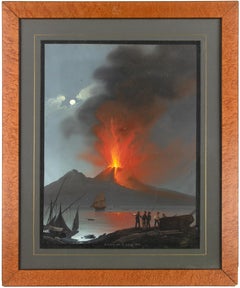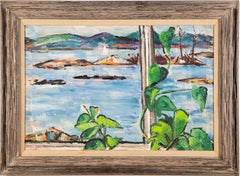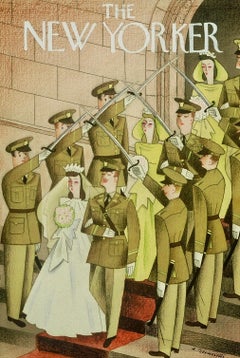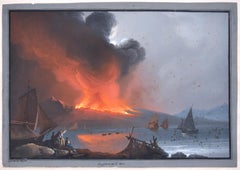Camillo de Vito Art
Italian, b. 1801
Camillo de Vito was a real gouache specialist and painter of the eruptions of Vesuvius and views of the Neapolitan landscape such as Notturno of the Ferdinandea island (1831) or Eruption of Vesuvius of 19 December, 1820, which derived from the illustrations of a coeval text description of the island King Ferdinand. He is still remembered by the sources as "painter of views of Naples."
to
1
1
Overall Width
to
Overall Height
to
1
1
1
1
1
1
1
1
1
1
1
1
9,961
2,752
1,376
1,372
1
1
Artist: Camillo de Vito
Eruption of Vesuvium - Gouache by C. De Vito - 1839
By Camillo de Vito
Located in Roma, IT
Vivid and fresh representation of one of the most spectacular and last eruptions of Vesuvium, that of January 1-5, 1839.
Wonderful conditions.
Framed in walnut and with passepartout...
Category
1830s Camillo de Vito Art
Materials
Gouache, Paint
$7,074 Sale Price
30% Off
Related Items
Antique American Modernist Nature Study Lake Landscape Framed Oil Painting
Located in Buffalo, NY
Antique American modernist landscape oil painting. Oil on canvas, circa 1940. Signed illegibly lower left. Image size, 36L x 24H. Housed in a period modern frame.
Category
1940s Modern Camillo de Vito Art
Materials
Canvas, Oil, Gouache
$796 Sale Price
20% Off
H 33 in W 45 in D 2 in
Original Painting New Yorker Mag Cover proposal. Army Wedding American Scene WPA
By Antonio Petruccelli
Located in New York, NY
Original Painting New Yorker Mag Cover proposal. Army Wedding American Scene WPA
Antonio Petruccelli (1907 – 1994)
Army Wedding
New Yorker cover proposal, c. 1939
11 1/2 X 8 inches ...
Category
1930s American Realist Camillo de Vito Art
Materials
Gouache, Board
Antique American Modernist Beach Sunset Landscape Original Hampton Oil Painting
Located in Buffalo, NY
Vintage American modernist landscape oil painting. Oil on canvas, circa 1940. No signature found. Displayed in a period modern frame. Image, 20"L x 16"H.
Category
1940s Abstract Camillo de Vito Art
Materials
Oil, Gouache
$796 Sale Price
20% Off
H 18 in W 22 in D 2 in
Vintage Mediterranean Port and Boats Landscape Painting
Located in Houston, TX
Charming painting of a Mediterranean town, two men untangle a fishnet while beach goers frolic on the shore, circa 1940.
Original one-of-a-kind vintage work of art on paper displaye...
Category
1940s Other Art Style Camillo de Vito Art
Materials
Paper, Gouache
Original Painting Undersea Whale Life Mag Published 1953 Illustration Ocean Sea
By Antonio Petruccelli
Located in New York, NY
Original Painting Undersea Whale Life Mag Published 1953 Illustration Ocean Sea
Antonio Petruccelli (1907 – 1994)
Underwater Whale
Life Illustration published, c. November 7, 1953
1...
Category
1950s American Realist Camillo de Vito Art
Materials
Gouache, Board
Industrial French Skyline with Bridge
Located in Houston, TX
French mid-century gouache painting on paper of industrial skyline with bridge in foreground.
Original artwork on paper displayed on a white mat with a gold border. Archival plastic...
Category
1950s Camillo de Vito Art
Materials
Paper, Gouache
View of the Ovo Castle in the Moonlight, a 19th century Neapolitan gouache
Located in PARIS, FR
Neapolitan gouaches appeared in the eighteenth century when tourism in the Naples area was developing: the discoveries of Herculaneum and Pompeii made this city a mandatory stop on the Grand Tour, the journey made by wealthy Europeans to complete their education.
Generally small in size for ease of transport and affordable in price, these gouaches were the ideal travel souvenir that these tourists of the early days were bringing back to capture the idyllic landscapes they had discovered during their journey and to share them with family and friends upon their return at home.
The Bay of Naples and the eruptions of Vesuvius are the favourite themes of these views. Here we have a view of the Ovo Castle, which was rebuilt on the island of Partenope, in the middle of the Bay of Naples and about a hundred metres from the shore by the Normans in the 12th century on antique ruins...
Category
Early 19th Century Romantic Camillo de Vito Art
Materials
Paper, Gouache
$1,426
H 12.19 in W 14 in
Connemara Landsacape Ireland
Located in GB
William Gronow‑Davis (1941–2015)
British painter, collector, and estate custodian
William Gronow‑Davis was born in 1941 in India and later moved to England, where he established hi...
Category
20th Century English School Camillo de Vito Art
Materials
Gouache, Archival Paper
1950s "Mound Street" Mid Century Figurative Painting American Modernist
By Donald Stacy
Located in Arp, TX
Donald Stacy
"Mound Street"
c. 1950s
Gouache paint on paper
24" x 18'" unframed
Unsigned
Came from artist's estate
For sale is a striking black and white painting titled "Mound Stre...
Category
Mid-20th Century American Modern Camillo de Vito Art
Materials
Paper, Gouache
$570 Sale Price
40% Off
H 18 in W 24 in
A 19th-Century Vista of Palermo and Monte Pellegrino
Located in San Francisco, CA
It’s a lovely vista even today from this hillside spot recently ravaged by fire and filled in by 8- to 10-story high-rises in the basin below. Yet this work is a time capsule back to...
Category
19th Century Italian School Camillo de Vito Art
Materials
Paper, Gouache
Antique American School Modernist Abstract Cityscape Signed Original Painting
Located in Buffalo, NY
Antique American modernist cityscape oil painting. Oil on canvas, circa 1970. Signed. Displayed in a giltwood frame. Image, 20"L x...
Category
1970s Modern Camillo de Vito Art
Materials
Oil, Watercolor, Gouache
$796 Sale Price
20% Off
H 25 in W 30 in D 2 in
Art Week Poster Design American Scene Modern c. 1930s WPA Era Illustration
By Antonio Petruccelli
Located in New York, NY
Art Week Poster Design American Scene Modern c. 1930s WPA Era Illustration
Antonio Petruccelli (1907 - 1994)
Art Week
22 X 17 inches
Gouache on board, c. 19...
Category
1930s American Modern Camillo de Vito Art
Materials
Gouache, Board
Previously Available Items
Eruption of Vesuvium 1810 - Original Gouache by Camillo de Vito - 1810
By Camillo de Vito
Located in Roma, IT
Eruzione del 1810 is a wonderful gouache on paper, made around 1810 by the Italian painter Camillo de Vito.
Title and signature in black tempera on the lower margin.
This is a really beautiful gouache of the first half of the nineteenth century representing the spectacular phenomena of the eruption of Vesuvius in 1810 under a suggestive full moon obscured by an cloud of ash and lapilli, still today marvels for the brilliance of the lava colors and which seems to be really glowing . It makes that feeling palpable, which is also an Enlightenment aesthetic category, of the sublime, or of the ecstasy mixed with the fear of man in the face of natural phenomena of this magnitude. We feel like the fisherman portrayed in the foregroud and bewildered in front of this show.
In Good condition, it preserves the brightness of the colors and shows a very loose hand, with some very small abrasion and widespread fungal blooms, margins with some abrasion, a light water stain at the center and a light wavy paper.
Since Vesuvius awakens, starting in 1631, the volcano becomes an iconic image of the city of Naples. His eruptions attracted incredibly scholars and visitors from all over the world. First represented for devotional purposes with San Gennaro next to the crater, it later became a must for the Grand Tour, together with the ruins of Pompeii and Herculaneum, it is painted and celebrated by a large number of renowned foreign artists. Claude-Joseph Vernet, Hubert Robert, Jean-Honoré Fragonard establish new iconographic canons for the representation of Vesuvius and its surroundings which become simplified the reference models in the following century.
It was the German Jacques Philipp Hackert (1737-1807) who rediscovered the technique of the gouache at the end of the 18th century and Pietro Fabris (doc. 1754 - 1779) who used it in the representations of Vesuvius in eruption, commissioned by Sir William Hamilton (1779) , as a supplement to five works at Campi Phlegraei...
Category
1810s Camillo de Vito Art
Materials
Gouache
H 18.39 in W 26.38 in D 0.16 in
Camillo De Vito art for sale on 1stDibs.
Find a wide variety of authentic Camillo de Vito art available for sale on 1stDibs. You can also browse by medium to find art by Camillo de Vito in gouache, paint, watercolor and more. Not every interior allows for large Camillo de Vito art, so small editions measuring 24 inches across are available. Customers who are interested in this artist might also find the work of Giancarlo Gorini, Silvia De Bastiani, and Laura Federici. Camillo de Vito art prices can differ depending upon medium, time period and other attributes. On 1stDibs, the price for these items starts at $6,629 and tops out at $6,629, while the average work can sell for $6,629.



